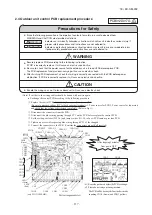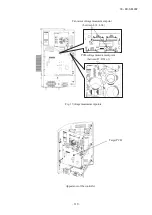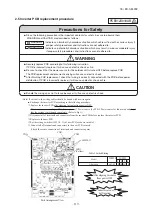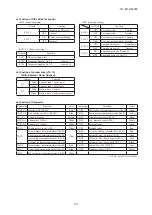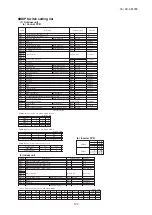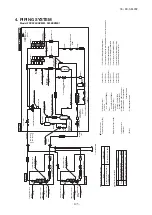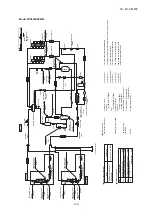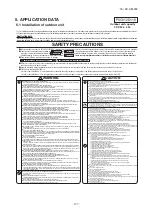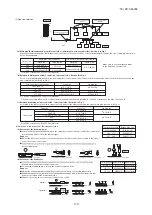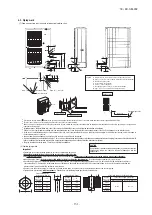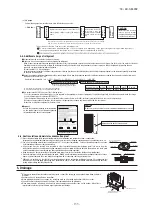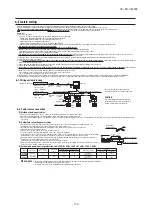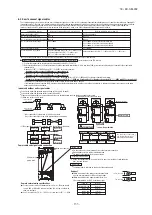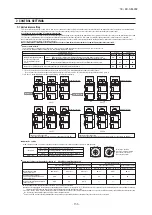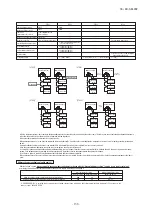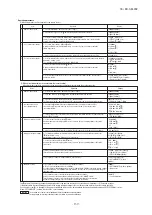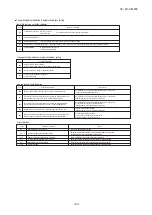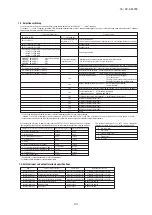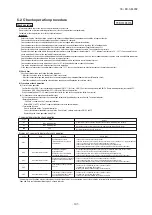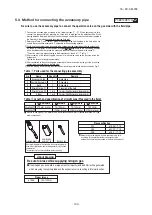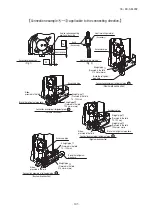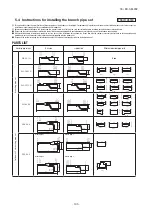
–
131
–
'18 • KX-SM-292
4-4. Additional charge of refrigerant
●
Refrigerant must be in the state of fluid when charging.
●
Make sure to use a measuring device when charging the refrigerant.
When it cannot charge whole required quantity because the outdoor unit is stopped, operate the unit in the test run mode and charge. (See Section 8 for the method of test run.)
Operating the unit for a long period of time with insufficient quantity of refrigerant could cause malfunction on the compressor. (When charging while operating the unit,
especially, complete the charge within 30 minutes.)
This unit contains 11.5 kg of refrigerant.
Calculate necessary quantity of additional charge with the following formula, and record the quantity of additionally charged refrigerant on the refrigerant quantity list provided
on the back of service panel.
●
Charge the additional refrigerant depending on the size and length of fluid pipe. Determine the quantity of additional charge by rounding the second place after decimal point,
which means in the unit of 0.1 kg.
(2) Field piping work
Important
Securely tighten the cap and the blind nut after the adjustment.
Avoid applying any excessive force when operating the shaft or when
tightening the cap or blind nut. Otherwise, it could cause malfunction or
leakage from the shaft, cap or blind nut.
(2) Air purge
Perform the air purge from both the check joints at fluid side and gas side.
This product uses R410A. Take care of the following points.
To avoid contamination with different type of oil, use separate tools depending on the type of refrigerant. It is prohibited especially to
use the gauge manifold and the charge hose for different types of refrigerant (R22, R407C).
<Work flow>
When the needle pointer of vacuum gauge has crept up, it means that there is moisture in or leakage
from the system. Identify and repair the leaking position and then perform the air purge again.
Operate the vacuum pump for more than 1 hour
after achieving -10 kPa or under (-765 mmHg or
under.
After letting it alone for
more than 1 hour, the
pointer needle of vacuum
gauge should not creep
up.
CAUTION
Insufficient degree of vacuum
causes a capacity shortage,
clogging by remaining moisture
or malfunction of compressor
A
Attached pipe connecting outlet at refrigerant gas side
B
Pipe connection outlet at liquid refrigerant side (Slot 50x94)
C
Refrigerant pipe outlet
D
Power cable outlet (ø30)
E
Power cable outlet (ø45)
F
Refrigerant pipe connection outlet (Slot 50x94)
G
Pipe connection outlet at gas refrigerant side
Legend
L3: Tot al length of ø15.88 pipes (m), L4: Total length of ø12.7 pipes (m)
L5: Total length of ø0.952 pipes (m), L6: Total length of ø6.35 pipes (m)
●
This product uses R410A. Take care of the following points.
∙
To avoid contamination with different type of oil, use separate tools depending on the type of refrigerant. It is prohibited especially to use the gauge manifold and the charge
hose for different types of refrigerant (R22, R407C).
∙
Type of refrigerant is indicated with the color painted on the container (Yellow for R140A). Sufficient care must be taken to use correct refrigerant only.
∙
Never use a charge cylinder. Otherwise, the composition of refrigerant may change when introducing R410A into the cylinder.
∙
Make sure to charge the refrigerant in the state of fluid.
●
Request
Record the refrigerant quantity calculated based
on the piping length in the refrigerant quantity
list provided on the back of service panel.
4-5. Heat insulation and moisture condensation proof
Refrigerant pipe size
Additional charge quantity(kg/m
)
ø15.88
0.17
ø12.7
0.11
ø9.52
0.054
ø6.35
0.022
Remark
6-2. Power source connection
6-1. Wiring system drawing
6. Electric wiring
5. Drainage
(3) Outdoor unit power source specification: 380/415V 3N~ 50Hz 380V 3N~ 60Hz 220V 3~ 60Hz
Model
224KXZME1
280KXZME1
335KXZME1
Power source
Three-phase
380/415V 50Hz
380V 60Hz
Cable size for
power source (mm
2
)
5.5
8
Rated current
30
30
30
30
2
2
M5
M5
54
68
Switch capacity
Earth leakage breaker
Size (mm
2
)
Screw type
Hook
Service valve size
(mm)
Tightening angle
(° )
Tightening torque
(N
・
m)
Recommended length of tool handle
(mm)
ø
6.35
(
1/4"
)
14
-
18
45
-
60
ø
9.52
(
3/8"
)
34
-
42
30
-
45
ø
12.7
(
1/2"
)
49
-
61
30
-
45
ø
15.8
8
(
5/8"
)
68
-
82
15
-
20
ø
19.05 (3/4"
)
100
-
120
15
-
20
150
200
250
300
450
Service
valve size
(mm)
Cap tightening torque
(N
・
m)
Shaft tightening torque
(N
・
m)
Check joint blind nut
tightening torque
(N
・
m)
ø
9.52
(
3/8"
)
6
-
20
-
10
-
12
ø
12.7
(
1/2"
)
14
-
25
8
16
-
10
-
12
ø
19.05 (3/4"
)
3
30
-
12
30
35
35
-
14
4-2. Piping work
Standard torque at sections on service valve
Allen wrench
(M4)
Fluid/gas service valve
Open
・
Open the valve stem till it hits the stopper. No need to apply
force more than that.
・
After the adjustment, replace the blind nut as it was.
・
After the adjustment, replace the cap as it
was.
Remove the cap and adjust as shown below
State at shipping (closed)
State of open
Pin type
▲
Allen wrench type
▲
Stopper
Pin
Drain elbow (1 pc)
Drain grommet (3 pcs.)
Commercial general purpose hard
polycarbonate pipe, VP16
●
Where water drained from the outdoor unit may freeze, connect the drain pipe using optional drain elbow and drain
grommet.
●
Outdoor unit has 4 drain outlets on the bottom.
●
When guiding drain water to a scupper, etc, install the parts on a flat stand (option item), blocks, or other.
●
Connect the drain elbow as shown by the figure. Seal remaining holes with grommets.
●
When draining water collectively, use holes for wires and pipes opened other than on the bottom. When this is
impracticable, sufficiently seal the drain pipe to prevent water leakage.
(1) Pipe connecting position and pipe outgoing direction
〈Ⅰ〉
Power source (outdoor unit side)
Outdoor unit
Power source (indoor unit side)
Grounding work
Grounding work
Earth leakage
breaker
Circuit breaker
for cabling
Earth leakage
breaker
Circuit breaker
for cabling
Indoor unit
Remote control wire
〈Ⅱ〉
X・Y
X・Y
X・Y
X・Y
X・Y
X・Y
A・B
A・B
L1・L2・L3
or
L1・L2・L3・N
1
・
2
1
・
2
Signal wire (between indoor units)
Remote
control
〈Ⅷ〉
A・B
1
・
2
・・・
・・・
・・・
・・・
A1・B1
Signal wire (between outdoor - indoor units
〈Ⅰ〉
)
(Example of combination)
Front connection
Bottom connection
Right-hand side connection
Rear connection
Outdoor unit
4-3. Air tightness test and air purge
(1) Air tightness test
Completion of air tightness test
Start of air purge
Completion of air purge
Degree of vacuum check
Refrigerant charge
Additional charge quantity
(
kg
)=
2.5
+(
L3×0.17
)+(
L4×0.11
)+(
L5×0.054
)+(
L6×0.022
)
Standard additional refrigerant quantity
Make sure to charge this quantity in addition
to the charge quantity for the refrigerant piping.
Charge quantity for the refrigerant piping
Moulded-case circuit breaker (A)
Earth wire
Wire length
(m)
30A, 30mA
less than 0.1 sec
30A, 30mA
less than 0.1 sec
03
15
84
30
G
A
F
B
54 96
Drain outlet (
ø
20)
Figure in is for 335
Over 1.5m
Pipe fastening position
B
G
04
6
35
5
53
54
95
1
68
2
54
60
120
14
43
E
D
D
D
C
C
C
A
43
54
47
1
95
1
53
54
14
54
68
Attached on the back of service panel.
Refrigerant quantity label
CAUTION
Make sure to enter the data. The data is required at maintenance or service.
●
First remove the five screws ( mark) of the service panel and push it down into the direction of the arrow mark and then remove it by pulling it toward you.
●
The pipe can be laid in any of the following directions: side right, front, rear and downward.
●
Remove a knock-out plate provided on the pipe penetration to open a minimum necessary area and attach an edging material supplied as an accessory by cutting it to an appropriate
length before laying a pipe.
●
In laying pipes on the installation site, cut off the casing’s half blank that covers a hole for pipe penetration with nippers.
●
If there is a risk of small animals entering from the pipe penetration part, close the part with some sealing material or the like (to be arranged on the installer’s part).
●
I
n the case of an installation using a collective drain system, use a port other than the bottom one to take out cables and pipes. If the bottom port is used, seal it thoroughly so
that drain water may not spill out.
●
Use an elbow (to be arranged on the user’s part) to connect control valves to the piping.
●
In anchoring piping on the installation site, give 1.5m or a longer distance between an outdoor unit and an anchoring point where the piping is secured as illustrated below. (A
failure to observe this instruction may result in a pipe fracture depending on a method of isolating vibrations employed.)
●
The pipe should be anchored every 1.5m or less to isolate the vibration.
H
Flare nut parallel side
measurement: H (mm)
φ
6.35
φ
9.52
φ
12.7
φ
15.88
Copper
pipe outer
diameter
H
17
22
26
29
A
B
Flared pipe end: A (mm)
Copper pipe protrusion for flaring: B (mm)
φ
6.35
φ
9.52
φ
12.7
φ
15.88
Copper
pipe outer
diameter
0
-0.4
A
9.1
13.2
16.6
19.7
φ
6.35
φ
9.52
φ
12.7
φ
15.88
Copper
pipe outer
diameter
In the case of a rigid (clutch) type
With an R410A tool
With a conventional tool
0
-
0.5
0.7
-
1.3
CAUTION
If you tighten it without using double spanners, you may deform the
service valve, which can cause an inflow of nitrogen gas into the
outdoor unit.
●
Please take care so that installed pipes may not touch components within a unit.
●
During the pipe installation at site, keep the service valves shut all the time
.
●
Give
sufficient protections
(compressed and brazed or by an adhesive tape)
to pipe ends so that any water or foreign matters may not enter the pipes
.
●
In bending a pipe, bend it
to the largest possible radius (at least four times the pipe diameter)
. Do not bend a pipe repeatedly to correct its form.
●
An outdoor unit’s pipe and refrigerant piping are to be flare connected. Flare a pipe after engaging a flare nut onto it. A flare size for R410A is different from that for
conventional R407C. Although we recommend the use of flaring tools developed specifically for R410A, conventional flaring tools can also be used by adjusting the
measurement of protrusion B with a protrusion control gauge.
●
Be sure to use the accessory pipe for connection to the gas service valve. For details, refer to the installation manual of the accessory pipe.
●
Tighten a flare joint securely
with two spanners
. Observe flare nut tightening torque specified in the table below.
Use a torque wrench. If a torque wrench is not available,
fasten the flare nut manually first and then tighten it
further, using the left table as a guide.
Do not hold the valve cap area with a spanner.
●
Do not apply any oil on a flare joint.
●
Blazing must be performed under a nitrogen gas flow
. Without nitrogen gas, a large quantity of foreign matters (oxidized film) are created, causing a critical failure
from capillary tube or expansion valve clogging.
●
Brazing of the service valve and the pipes should be performed while cooling the valve body with a wet towel.
●
Perform flushing. To flush the piping, charge nitrogen gas at about 0.02 MPa with a pipe end closed with a hand. When pressure inside builds up to a sufficient level,
remove the hand to flush. (in flushing a pipe, close the other end of the pipe with a plug).
Plug the end of the pipe with tape, or other
material, and fill the pipe with nitrogen gas.
Only use nitrogen gas (N
2
)
Taping
<
N
2
>
Nitrogen
Brazing
Brazing
Flatten
Adhesive tape
Station valve
Primary side
Secondary side
0.02MPa
Hand
Relief valve
Nitrogen
gas
Operation procedure
①
During the pipe installation at site, keep the service valves shut all the time
.
②
Blazing must be performed under a nitrogen gas flow
. Without nitrogen gas, a large
quantity of foreign matters (oxidized film) are created, causing a critical failure from capillary
tube or expansion valve clogging.
③
Give
sufficient protections
(compressed and brazed or with an adhesive tape)
so that water or foreign matters may not enter the piping
.
④
Perform flushing. To flush the piping, charge nitrogen gas at about 0.02 MPa with a pipe end
closed with a hand. When pressure inside builds up to a sufficient level, remove the hand to
flush. (in flushing a pipe, close the other end of the pipe with a plug).
Nitrogen
gas
①
Although an outdoor unit itself has been tested for air tightness at the factory, please check the connected pipes and indoor units for air tightness from the check joint of
the service valve on the outdoor unit side. While conducting a test,
keep the service valve shut all the time
.
②
Since refrigerant piping is pressurized to the design pressure of a unit with nitrogen gas for testing air tightness, please connect instruments according the drawing below.
Under no circumstances should chlorine-based refrigerant, oxygen or any other combustible gas be used to pressurize a system.
Keep the service valve shut all the time
. Do not open it under any circumstances.
Be sure to pressurize all of the liquid, gas pipes
.
③
In pressurizing the piping, do not apply the specified level of pressure all at once, but gradually raise pressure.
a)
Raise the pressure to 0.5 MPa, and then stop. Leave it for five minutes or more
to see if the pressure drops.
b)
Then raise the pressure to 1.5 MPa, and stop. Leave it for five more minutes
to see if the pressure drops.
c) Then raise the pressure to the specified level (4.15 MPa), and record the ambient temperature and the pressure.
d)
If no pressure drop is observed with an installation pressurized to
the specified level
and left for about one day
,
it is acceptable
. When the ambient temperature
changes 1 C , the pressure also changes approximately 0.01 MPa. The pressure, if changed, should be compensated for.
e) If a pressure drop is observed in checking e) and a) – d), a leak exists somewhere. Find a leak by applying bubble test liquid to welded parts and flare joints and repair
it. After repair, conduct an air-tightness test again.
④
Always pull air from the pipes after the airtightness test.
To indoor unit
Gauge manifold
Lo
Lo knob
Hi
Hi knob
Service point
(check joint)
Service valve
Liquid pipe
Gas pipe
Outdoor unit
CAUTION
Applying excessive pressure can cause an
inflow of nitrogen gas into an outdoor unit.
(1) Dress refrigerant pipes (both gas and liquid pipes) for heat insulation and prevention of dew condensation.
Improper heat insulation/anti-dew dressing can result in a water leak or dripping causing damage to household effects, etc.
(2) Use a heat insulating material that can withstand 120
℃
or a higher temperature. Poor heat insulating capacity can cause
heat insulation problems or cable deterioration.
●
All gas pipes must be securely heat insulated in order to prevent damage from dripping water that comes from the
condensation formed on them during a cooling operation or personal injury from burns because their surface can reach quite
a high temperature due to discharged gas flowing inside during a heating operation.
●
Wrap indoor units’ flare joints with heat insulating parts (pipe cover) for heat insulation (both gas and liquid pipes).
●
Give heat insulation to both gas and liquid side pipes. Bundle a heat insulating material and a pipe tightly together so that no
gaps may be left between them and wrap them together with a connecting cable by a dressing tape.
●
Although it is verified in a test that this air- conditioning unit shows satisfactory performance under JIS condensation test
conditions, both gas and liquid pipes need to be dressed with 20mm, or over, heat insulation materials additionally above the
ceiling where relative humidity exceeds 70%.
Wires for connecting indoor
and outdoor units
Exterior tape
Gas piping
Insulation
Liquid piping
Band (accessory)
Pipe cover (accessory)
Electrical installation work must be performed by an electrical installation service provider qualified by a power provider of the country.
Electrical installation work must be executed according to the technical standards and other regulations applicable to electrical installations in the country.
Please install an earth leakage breaker without fail
. The installation of an earth leakage breaker is compulsory in order to prevent electric shocks or fire accidents.
(Since this unit employs inverter control, please
use an impulse withstanding type
to prevent an earth leakage breaker’s false actuation.)
Please note
a) Use only copper wires.
Do not use any supply cord lighter than one specified in parentheses for each type below.
- braided cord (code designation 60245 IEC 51), if allowed in the relevant part 2;
- ordinary tough rubber sheathed cord (code designation 60245 IEC 53);
- flat twin tinsel cord (code designation 60227 IEC 41)
- ordinary polyvinyl chloride sheathed cord (code designation 60227 IEC 53).
Please do not use anything lighter than polychloroprene sheathed flexible cord (cord designation 60245 IEC57) for supply cords of parts of appliances for outdoor use.
b)
Use separate power source for the indoor and outdoor units
.
c)
The power source for indoor units in the same system should turn on and off simultaneously
.
d) Ground the unit. Do not connect the grounding wire to a gas pipe, water pipe, lightning rod or telephone grounding wire.
A grounding wire must be connected before connecting the power cable. Provide a grounding wire longer than the power cable.
If improperly grounded, an electric shock or malfunction may result.
e)
The installation of an impulse with standing type earth leakage breaker is necessary
. A failure to install an earth leakage breaker can result in an accident such as an electric shock or a fire.
Do not turn on the power until the electrical work is completed. Be sure to turn off the power when servicing.
f ) Please do not use a condensive capacitor for power factor improvement under any circumstances. (It does not improve power factor, while it can cause an abnormal overheat accident.)
g) For power source cables, use conduits.
h) Please
do not lay electronic control cables (remote control and signaling lines) and other high current cables together outside the unit
. Laying them together can result in malfunctioning or a
failure of the unit due to electric noises.
i ) Power cables and signaling lines must always be connected to the terminal block and secured by cable fastening clamps provided in the unit.
j ) Fasten cables so that they may not touch the piping, etc.
k)
When cables are connected, please make sure that all electrical components within the electrical component box are not free or not loose on the terminal connection
and then attach the
cover securely. (Improper cover attachment can result in malfunctioning or a failure of the unit, if water penetrates into the box.)
l ) Make sure to use circuit breakers (earth leakage breaker and circuit breaker) of proper capacity.
Use of breakers of larger capacity could result in trouble on components or fire accident.
The circuit
breaker
should
isolate
all
poles
under
over current.
m)
Install isolator or disconnect switch on the power source wiring in accordance with the local codes and regulations. The isolator should be locked in OFF state in accordance with EN60204-1.
n)
After maintenance, all wiring, wiring ties and the like, should be returned to their original state and wiring route, and the necessary clearance from all metal parts should be secured.
220/240V
~
50Hz
220V
~
60Hz
CAUTION
If the earth leakage breaker is exclusively for
ground fault protection, then you will need to
install a circuit breaker for wiring work.
*Do not connect N-phase wire to the unit
when the power source is 3-phase and 4-wire.
Round crimp
contact terminal
Crimp
contact terminal
Diameter of a cable:thin
Diameter of a cable:thick
Wire
(1) Method of leading out cables
●
As shown on the drawing in Section 4-2, cables can be laid through the front, right, left or bottom casing.
●
In wiring on the installation site, cut off a half-blank covering a penetration of the casing with nippers.
●
In the case of an installation using a collective drain system, use a port other than the bottom one to take out cables and pipes. If the bottom port is used, seal it thoroughly so that drain water may
not spill out.
(2) Notabilia in connecting power cables
●
Connect the ground wire before you connect the power cable. When you connect a grounding wire to a terminal block, use a
grounding wire longer than the power cable so that it may not be subject to tension.
●
Do not turn on power until installation work is completed. Turn off power to the unit before you service the unit.
●
Ensure that the unit is properly grounded.
●
Always connect power cables to the power terminal block.
●
To connect a cable to the power terminal block, use a round crimp contact terminal.
If two cables are to be connected to one terminal, arrange cables in such a manner that you put their crimp contact terminals
together back to back. Further, put the thinner cable above the thicker one in arranging cables for such connection.
●
Use specified wires in wiring, and fasten them securely in such a manner that the terminal blocks are not subject to external force.
●
In fastening a screw of a terminal block, use a correct-size driver.
Fastening a screw of a terminal block with excessive force can break the screw.
●
When electrical installation work is completed, make sure that all electrical components within the electrical component box are free
of loose connector coupling or terminal connection.
a) The method of laying cables has been determined pursuant to the Japanese indoor wiring regulations (JEAC8001).
(Please adapt it to the regulations in effect in each country.)
b) For details, please refer to the installation manual supplied with the indoor unit.
Please note
Terminal block
380/415V 3N
~
50Hz
380V 3N
~
60Hz
220V 3
~
50Hz/60Hz
220V 3N
~
60Hz*
service
Summary of Contents for FDC224KXZME1
Page 169: ... 168 18 KX SM 292 PHA012D402 ...
Page 170: ... 169 18 KX SM 292 Screw ...
Page 171: ... 170 18 KX SM 292 ...
Page 172: ... 171 18 KX SM 292 ...

